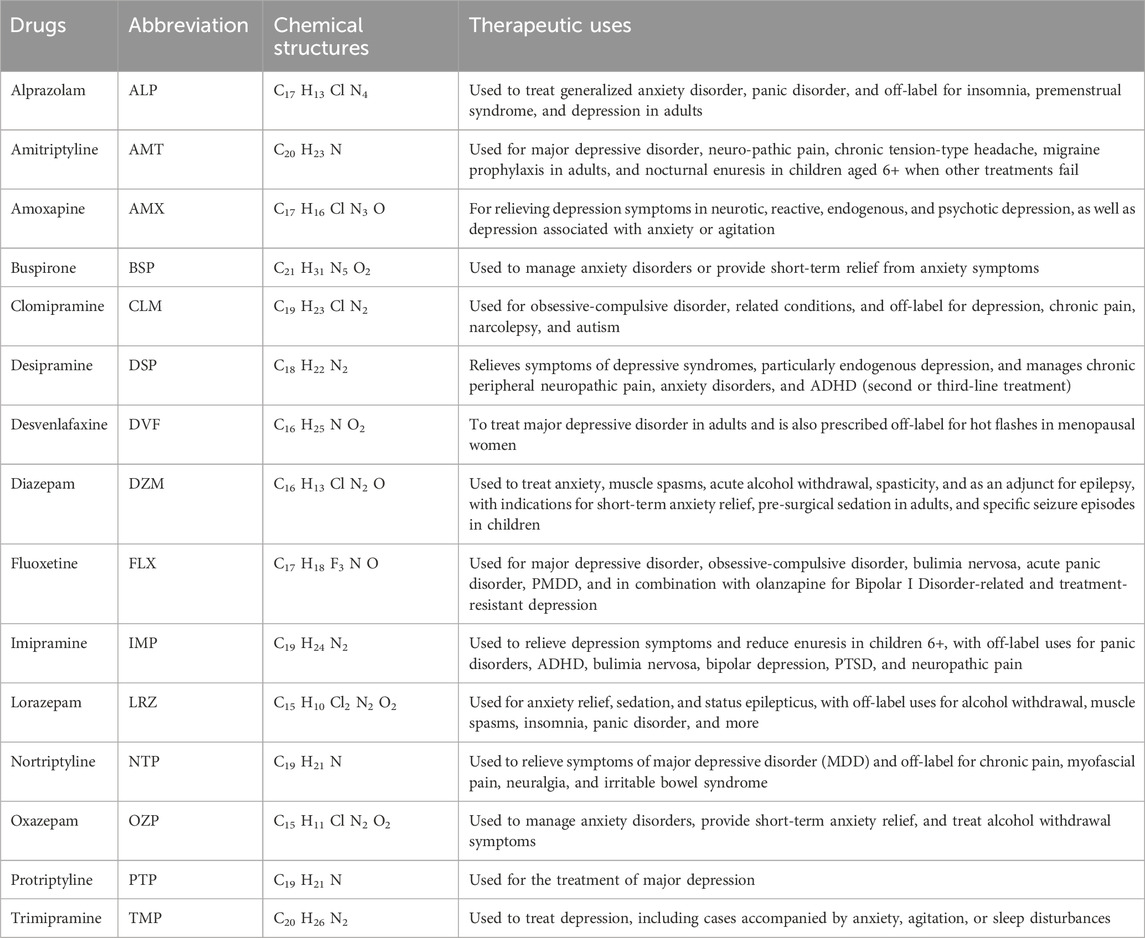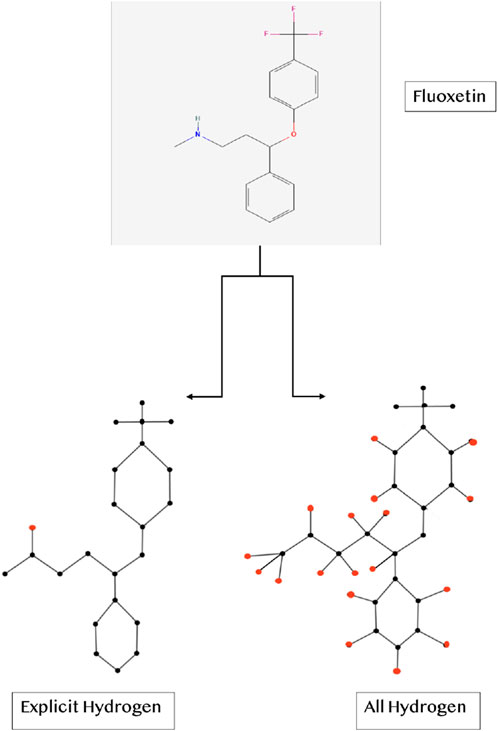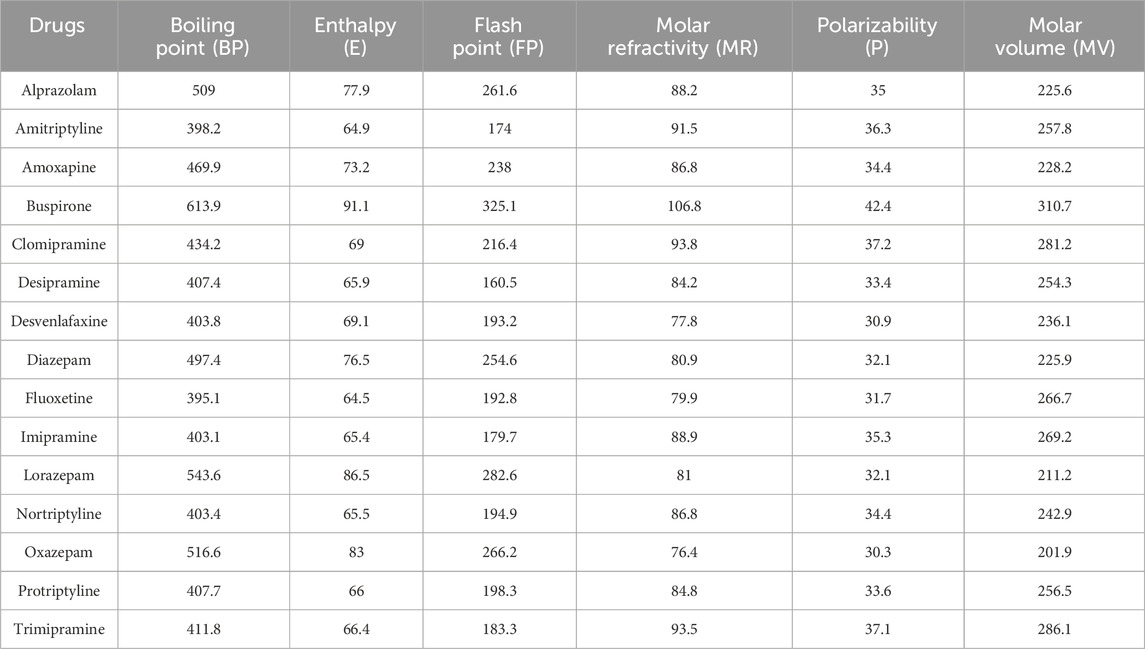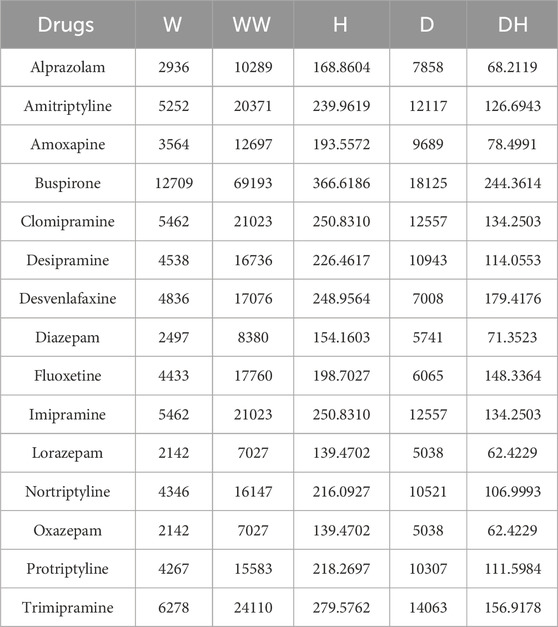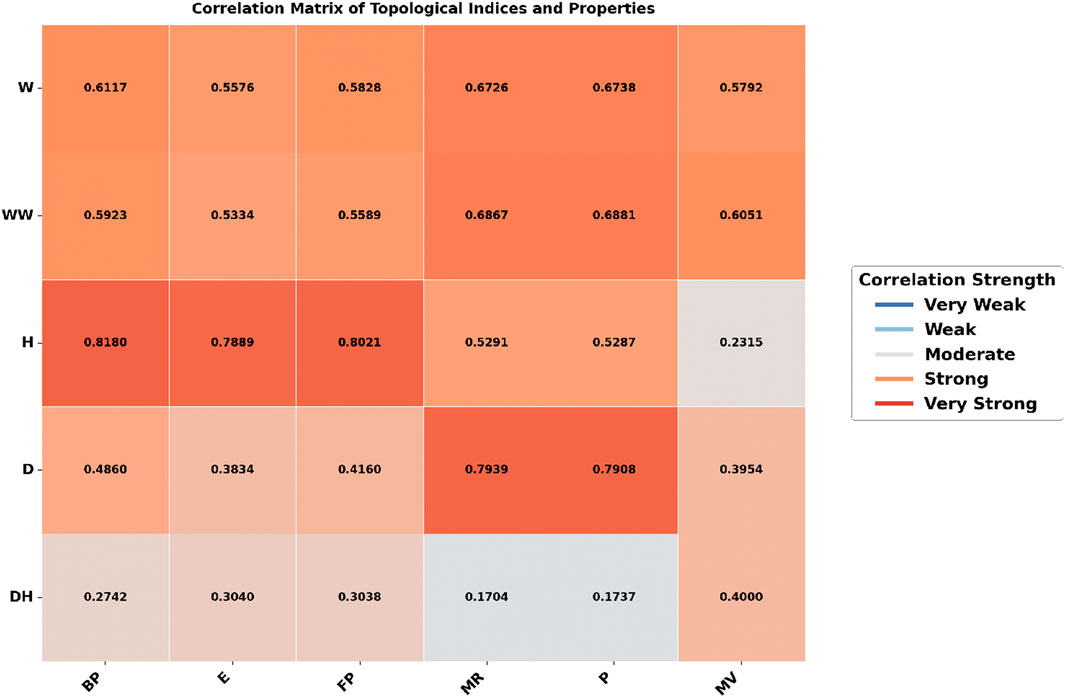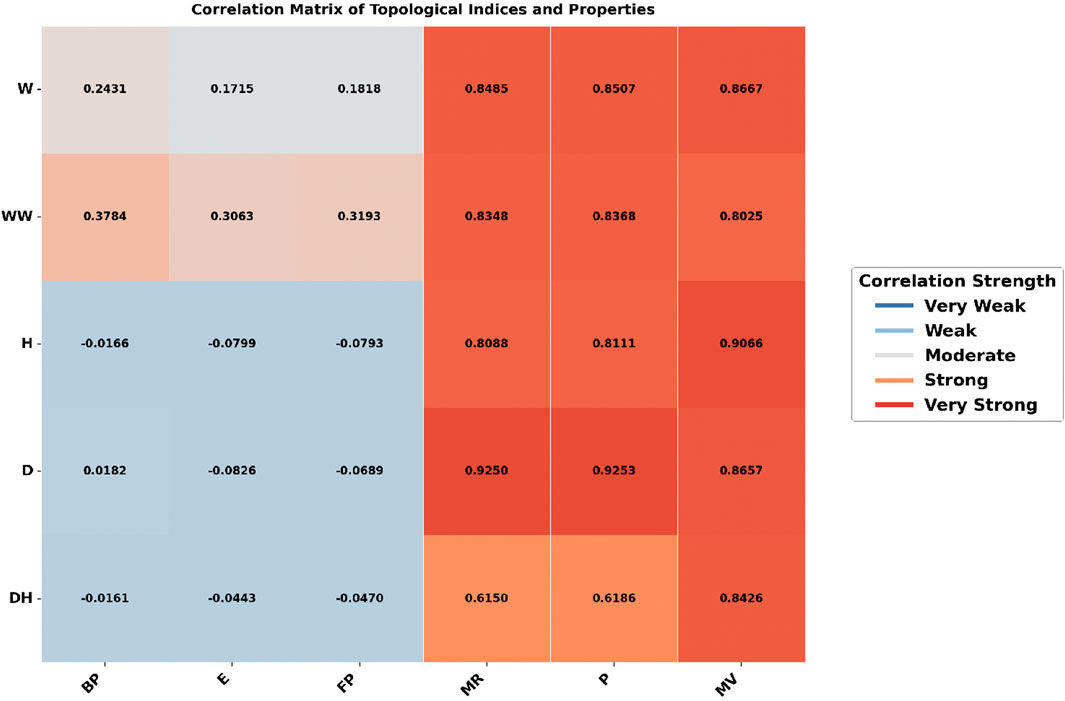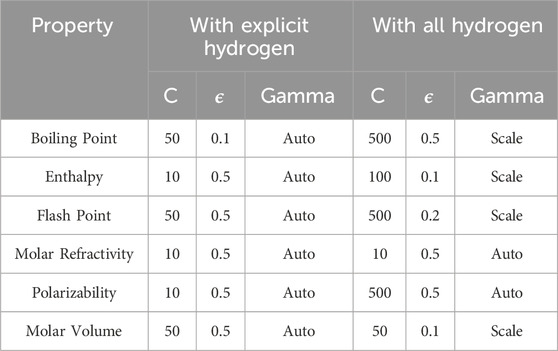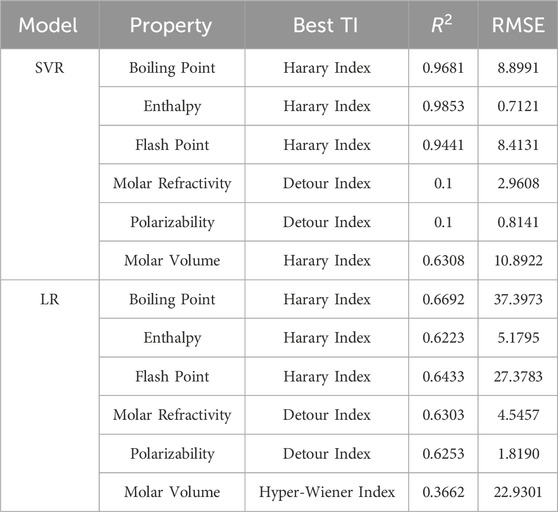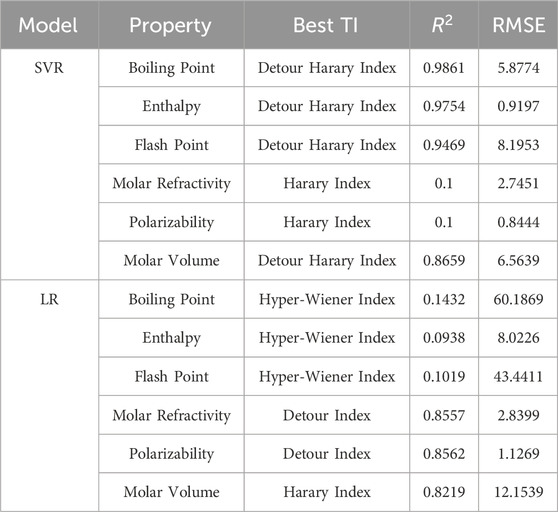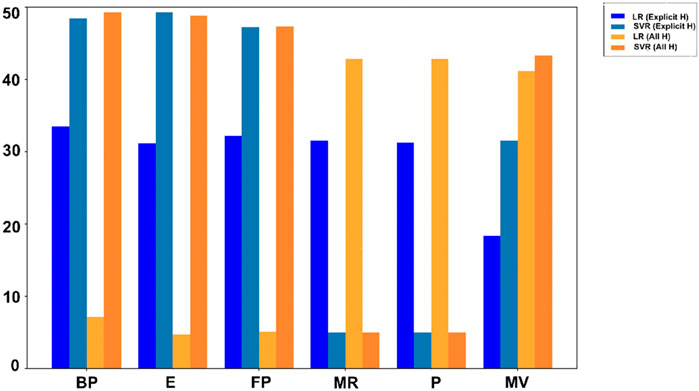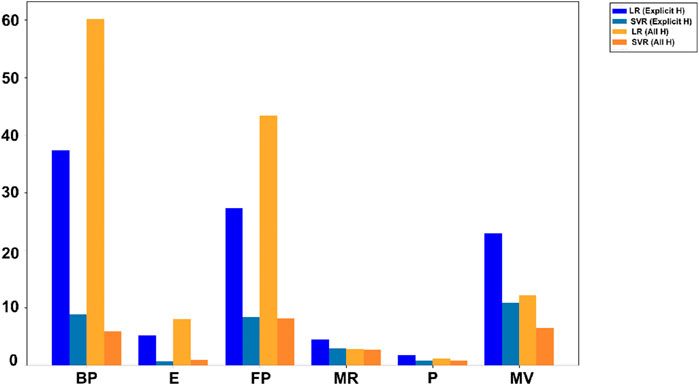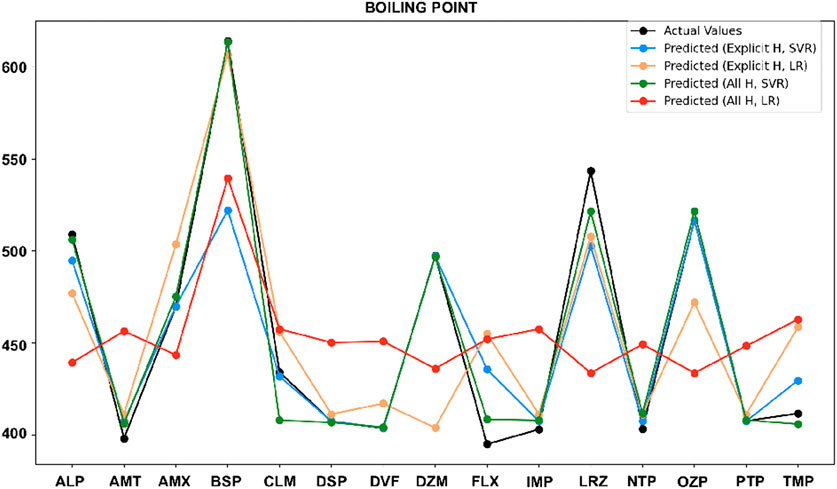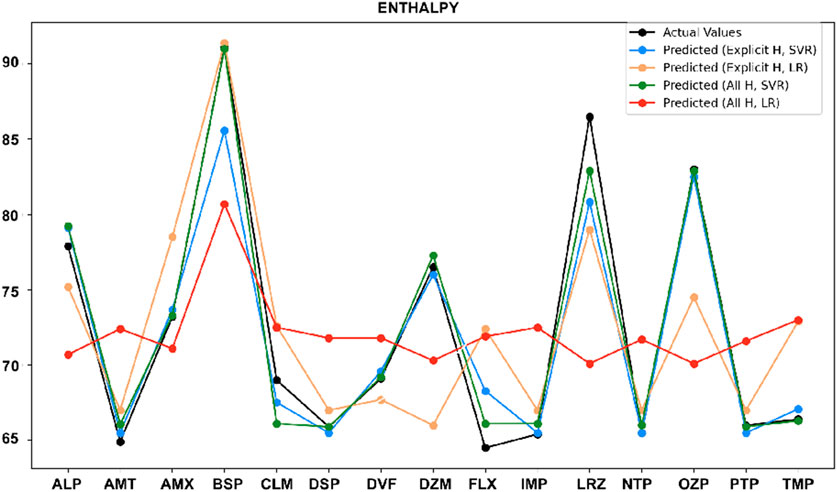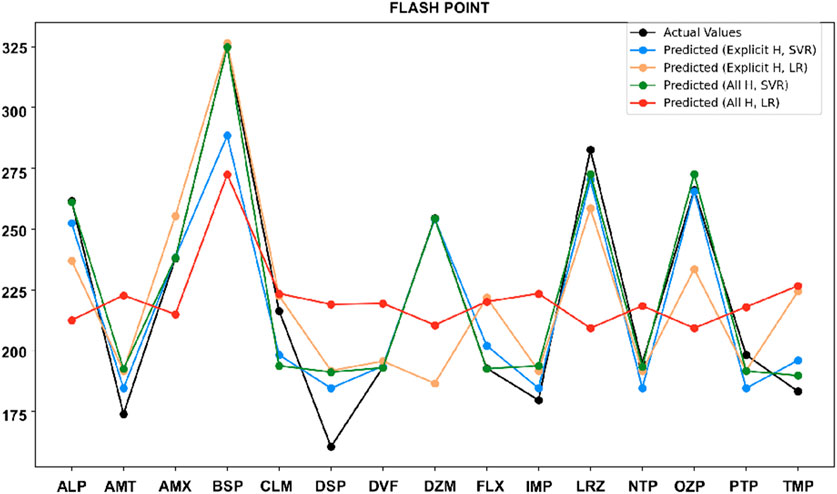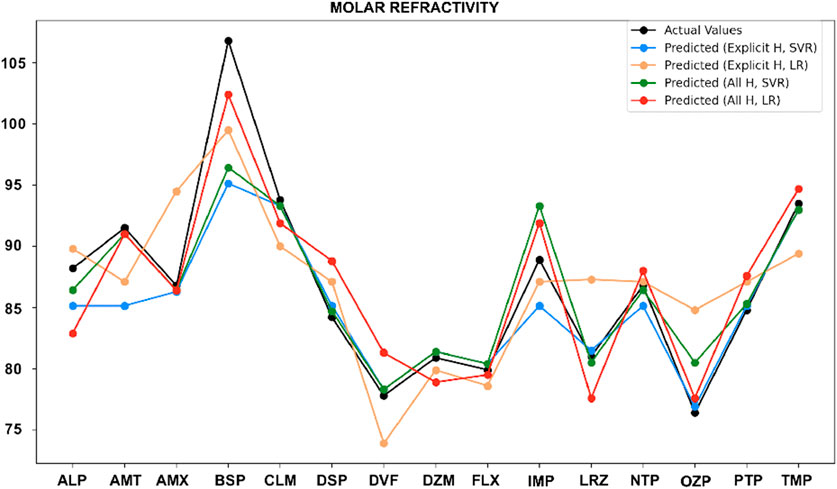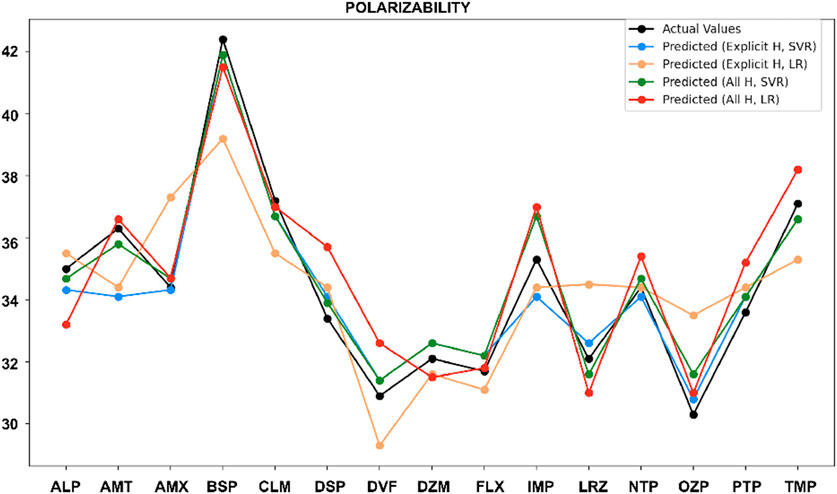- Department of Mathematics, School of Advanced Sciences, Vellore Institute of Technology, Vellore, Tamil Nadu, India
Introduction: Tricyclic anti-depressant (TCA) drugs are widely used to treat depression, but traditional methods for evaluating their physicochemical properties can be time-consuming and costly. This study examines how topological indices can help to predict the properties of TCA drugs, with a special focus on the role of the hydrogen representation.
Methods: Two molecular configurations were analyzed: one with only explicit hydrogen and the other including all hydrogen atoms. To assess predictive performance, linear regression (LR) and support vector regression (SVR) models were employed.
Results: The results showed that adding all hydrogen atoms showed strong correlations, especially for polarizability, molar refractivity, and molar volume. Among the models employed, SVR provided more accurate results. Additionally, hydrogen representation had a stronger impact on SVR's predictions.
Discussion: These findings highlight the potential of using machine learning techniques in quantitative structure-property relationship (QSPR) models for more efficient and reliable predictions of drug properties.
1 Introduction
Mental health disorders are a group of psychiatric conditions that can severely impact an individual’s ability to function in everyday environment, resulting in difficulties with daily activities, social connections, and behavioral stability (Ejima et al., 2024). Conditions such as anxiety, addiction, depression, and bipolar disorder are common, with depression being a particularly pressing public health concern that demands effective treatment options (Kessler et al., 2007). TCAs rank among the most commonly prescribed medications for depression, with over 25 million prescriptions written annually in the United States. However, despite their effectiveness, TCAs are frequently linked in overdose incidents, with studies showing that they contribute to nearly 25% of overdose-related hospital admissions at a major medical center (Marshall and Forker, 1982; Vandel et al., 1997). According to the 2023 NSDUH Report, 22.8% of adults (58.7 million) experienced any mental illness (AMI) in the past year, and 4.5 million adolescents reported a major depressive episode, with 20% also experiencing substance use disorders. Suicide remains a major worry, with 5.0% of adults having serious thoughts about it, 1.4% making plans, and 0.6% attempting suicide (Health and Services, 2023). These concerning statistics highlight the critical importance of prioritising mental health rehabilitation and preservation. While laboratory-based drug development has played a key role in advancing treatments for mental health, it is often resource intensive (Insel et al., 2013). Computational modeling and predictive techniques offer promising alternatives that are both cost-effective and resourceful. These approaches not only enhance traditional drug discovery but also provide accessible and effective therapy for those with neuropsychiatric disorders.
The process of drug design and discovery is a complex, time-consuming, and costly. To optimize this process, researchers have increasingly turned to predictive modeling techniques, particularly in resource-limited scenarios or during medical emergencies. One such approach is QSPR modeling, which predict a drug’s physicochemical properties based on its molecular structure and descriptors, commonly referred to as topological indices. Chemical graph theory applies the principles of graph theory to chemistry by representing molecules as graphs, where vertices correspond to atoms and edges to chemical bonds (Thapar et al., 2022). Topological indices, numerical descriptors derived from these graphs, capture critical structural information (Gutman and Polansky, 2012; Gutman, 2006). These indices serve as essential tools in QSPR modeling, as they establish mathematical relationships between molecular structures and biological or physicochemical properties, particularly in pharmaceutical research (Abubakar et al., 2024a). One of the earliest and most well-known topological indices is the Wiener Index, introduced in 1947, originally designed to predict the physical properties of paraffin compounds (Wiener, 1947). In recent years, topological indices have gained widespread popularity in QSPR studies, offering a cost-effective and time-saving alternative to experimental methods. By enabling researchers to predict key drug properties, identify influential structural features, and optimize drug candidates, these indices play a crucial role in accelerating drug development and reducing reliance on expensive laboratory experiments (Parveen et al., 2022; Zaman et al., 2023).
The use of topological indices in pharmaceutical research has significantly increased in recent years, particularly in QSPR studies. But, most QSPR modeling studies primarily focused on classical graph-based topological indices and simple regression models to establish relationships between topological indices and the physical properties of compounds. A topological index that exhibits a strong linear correlation with a physical property is regarded as an effective descriptor for predicting that property (Zaman et al., 2024; Das et al., 2024; Arockiaraj et al., 2024; Huang et al., 2024; Hasani and Ghods, 2024). However, when the relationship between topological indices and physical properties is non-linear, more advanced approaches like machine learning, are employed to capture complex patterns and improve predictive accuracy (Fernández-Blanco et al., 2013; Madugula et al., 2021; Abubakar et al., 2024b). Zabidi et al. (2021) applied machine learning to predict HOMO and LUMO, minimizing the need for computationally expensive DFT calculations. Degree-based topological indices were employed in QSPR analysis to establish correlations with these properties and identified Linear Regression with Moment Balaban Indices as the most accurate model. Costa et al. (2020) proposed explored a novel method for QSAR and QSPR modeling through Molecular Graph Theory, emphasizing molecular fragment contributions. By combining Molecular Graph Theory, SMILES notation, and connection table data, they established an efficient method for fragment identification. Machine learning techniques produced accurate predictive models, and the study introduced Charming QSAR and QSPR, a Python tool designed for property estimation in chemical compounds. Abubakar et al. (2024a) analyzed neighborhood degree-based topological indices for QSPR modeling of anti-tuberculosis drugs, employing Support Vector Regression (SVR) and comparing it to linear regression. The results demonstrated that SVR as a better predictive tool, enhancing the understanding of the non-linear relationship. Author A and others applied QSPR modeling with neighborhood sum degree topological indices to predict antibacterial drug properties. SVR outperformed linear regression, benefiting from feature selection and hyper-parameter tuning. Marshall and Forker (1982) investigated an ensemble learning approach for the analysis of mental disorder drugs. Using neighborhood degree-based indices derived from SMILES notations, the study identified optimal indices for predicting key physicochemical properties. Their findings showed the role of ensemble learning in better prediction accuracy, particularly for small datasets.
Additionally, it is important to note that none of the cited studies considered hydrogen atoms in their topological representations, which may neglect to important contribution to molecular properties. Furthermore, the all prior work relied on degree-based topological indices, which capture only local atomic environments. In our earlier study, the predictive power of topological indices for drug properties was explored using regression models along with distance-based indices. However, the influence of hydrogen configuration was not considered (Kour et al., 2024). In contrast, our present study demonstrated a novel comparison of explicit hydrogen and all hydrogen structures, using distance based indices that effectively capture molecular branching and spatial arrangement. Benchmarking LR and SVR, we observed that SVR provided superior accuracy for non-linear relationships, while LR performed well in strongly linear cases. This novel approach refines QSAR modeling, demonstrating how molecular representation influences predictive accuracy and optimizing regression techniques. The primary objective of this work is to understand the impact of hydrogen configuration on the prediction of six physicochemical properties using two regression techniques. This work aims to evaluate how different molecular representations impact prediction accuracy across multiple properties.
The major contributions in this study are:
2 Methodology and data collection
2.1 Drugs analysis
This study focuses on fifteen TCA drugs which have different molecular structure and clinical importance. Table 1 list their chemical structures and therapeutic uses, highlighting their role in treating depression and anxiety.
Two molecular representations, one including explicit hydrogen only and the other including all the hydrogen, were analyzed to understand the influence of hydrogen on the properties of drugs. Figure 1 presents an example of Fluoxetine, showing its two different configurations-one with explicit hydrogen and other with all hydrogen. The hydrogen atoms are highlighted in red color. Six physicochemical properties listed in Table 2, were obtained from PubChem (2025) and ChemSpider (2025). These properties help us understand the thermodynamic and structural characteristics of these compounds in further computational analyses.
2.2 Topological indices
The study explores the relationship between molecular properties and atomic arrangements using distance-based topological indices which are presented in Table 3. Similarly, calculations were performed for fifteen TCA drugs, analyzed with explicit hydrogen and with all the hydrogen. The results, presented in Tables 4, 5, provide numerical values that represent structural connectivity and molecular topology. These indices were selected due to their ability to capture spatial and str curtal complexity of the molecules. They effectively encode connectivity and branching patterns that influence molecular behavior.
Where,
The formulas for the topological indices remain the same for all the drugs, but they are calculated in two different ways according to the representation of hydrogen, one with only explicit hydrogen and other with all hydrogen. For preprocessing, all drug structure were standardized and convert into graph-based representations. These calculations are performed using Python and its libraries. RDKit is used to handle the molecular structures, NetworkX helps in creating the adjacency and distance matrices, and NumPy takes care of the numerical operations. The input for the molecular structures is provided in SMILES format—a simple text representation of molecules. First, molecules from PubChem are converted into graphs using RDKit. For explicit hydrogen calculation, the skeletal form of the molecule with Chem. MolFromSmiles (smiles) is used. And, for all hydrogen, we add explicit hydrogen atoms with Chem. AddHs(mol) which consider all the hydrogen present in a molecule.
2.3 Regression model
2.3.1 QSPR model
QSPR is a computational model which is used to predict the physical, chemical, or biological properties of molecules based on their molecular structure. QSPR models establish a mathematical relationship between molecular descriptor (topological index) and a target property (Todeschini and Consonni, 2009).
The formulation of QSPR is represented in Equation 1.
where,
2.3.2 Linear regression
Linear regression is a method used to establish the relationship between a dependent variable and an independent variable by fitting a straight line (Zaid, 2015).
The equation is represented in Equation 2.
where
The following LR model in Equation 3 is employed to construct a QSPR model.
where,
2.3.3 SVR theory
Support Vector Machines (SVM), introduced by Vapnik and others in 1995, are based on the structural risk minimization principle and statistical learning theory (Vapnik, 2013). SVM has been successfully applied to a wide range of classification and regression problems (Cai et al., 2003b; Cai et al., 2003a; Cortes and Vapnik, 1995; Smola and Schölkopf, 2004; Rao and Gopalakrishna, 2009). When used for regression, they are called support vector regression. Traditionally, QSPR models have relied on LR to predict compound properties because it is simple and interpretable. However, LR struggles with non-linear data and is sensitive to unusual data points. SVR addresses these limitations by effectively capturing non-linear patterns and showing more accurate and reliable predictions. These advantages make SVR a strong tool for combining with topological indices in QSPR studies (Awad and Khanna, 2015; Ardeshir et al., 2021; Baştanlar and Özuysal, 2013; Yang et al., 2005).
SVR focuses on developing a predictive model between given input features and their target values. Given a training dataset
SVR creates a function that is linear in a transformed feature space but can model complex, non-linear relationships in the original input space. This is done by applying a non-linear transformation
The regression function is defined in Equation 4.
where:
The major goal of the SVR model is to find the weight vector
subject to:
where:
In this study, radical basis function (RBF) has been implemented. The RBF kernel is a kernel that maps data to a higher dimensional space and is defined in Equation 9.
where,
2.4 Performance evaluation
2.4.1 Coefficient of determination
In regression analysis, the most commonly used statistic to assess model performance is the coefficient of determination
The formula for calculating R-squared is defined in Equation 10.
where,
2.4.2 Root mean squared error
The Root Mean Squared Error (RMSE) in the dataset is determined by taking the square root of the mean squared differences between the observed values and predicted values (Awad and Khanna, 2015; Sharma, 2005), given in Equation 11.
where,
3 Results and discussion
In this study, a QSPR analysis of fifteen TCA drugs has been performed, to understand their physicochemical properties, which play an important role in examining their efficacy, stability, and thermodynamic behavior. The focus is on the correlations between molecular topological indices and physicochemical properties, and the impact of hydrogen atoms. SVR and LR models with explicit hydrogen and all-hydrogen were used to predict the properties based on topological indices and compared their performances to find the more accurate model.
3.1 Heatmap analysis
The heatmap analysis, as shown in Figures 2, 3, compares the correlation between topological indices and physicochemical properties under two different molecular representations: explicit hydrogen and all hydrogen. The color intensity shows the strength of these relationships, darker colors mean a stronger correlation, while lighter colors mean a weaker one.
Figure 2, represents the dataset with explicit hydrogen only, shows a varied correlation pattern. The Harary Index has a strong correlation with Boiling Point (0.8180) and Flash Point (0.8021), but its correlation with Molar Refractivity (0.5291), Polarizability (0.5287), and Molar Volume (0.2315) is weaker. The Wiener and Hyper-Wiener indices show moderate relationships, especially with Molar Refractivity (0.6867) and Polarizability (0.6881). The Detour Harary Index has mostly weak correlations, as indicated by the lighter shades in the heatmap.
In contrast, Figure 3, where all hydrogen atoms are included, the correlation pattern appears more consistent. The Detour Index showed strong correlations for Molar Refractivity (0.9250), Polarizability (0.9253), and Molar Volume (0.8657). The Harary Index, which had strong correlations in Figure 1, now has much weaker correlations to Boiling Point (−0.0166) and Flash Point (−0.0793). The Detour Harary Index, which mostly has weak correlations, performs better with Molar Volume (0.8426) in this dataset.
3.2 SVR hyper-parameter tuning
The predictive model was developed using the SVR with the RBF kernel. The model was trained in Python using the scikit-learn library. The dataset was split into 80% training and 20% testing for better accuracy and validation. Hyper-parameter tuning was done to find the best values of the epsilon
3.3 Performance comparison: LR vs. SVR
In Tables 7, 8,
3.4 Comparison of actual vs. predicted values
It is observed from the earlier results that SVR is better than LR in term of prediction. In this section, comparison of actual values of drug properties, along with the predicted values from the SVR model and LR model, using both the explicit hydrogen and all-hydrogen are presented. Overall, the predicted values follow the actual trends closely, demonstrating the strong predictive capability of SVR for most cases.
These results show that molecular representation plays a key role in prediction accuracy. Both models perform well, but SVR with all-hydrogen model consistently provides more precise and accurate predictions, making it a better option for predicting drug properties. LR shows moderate performance, with occasional improvements when paired with explicit hydrogen models. This study underscores how including hydrogen in molecular structures enhances prediction accuracy.
It is evident that the SVR model generally outperformed the LR model, achieving higher
The findings of this study carry significant practical implications and offer a clear path for improving predictive modeling in drug discovery. It demonstrated the value of using machine learning techniques with chemically informative indices. Accurate prediction of properties is essential in the early stages of pharmaceutical development, where reliable estimation can guide compound selection. Such a framework can significantly reduce the need of time and cost experiment. Moreover, the ability to predict multiple molecular properties with high accuracy supports faster decision making in structure-activity relationship analysis. Overall, the proposed methodology offers a data-driven tool for better drug discovery pipeline by streamlining the evaluation of molecular drugs based on their predicted properties.
4 Conclusion
While SVR outperformed LR in most cases, LR also demonstrated strong performance for certain properties like molar refractivity and polarizability, making it valuable for understanding linear relationships between topological indices and specific molecular properties. These findings highlight the advantages of combining machine learning with topological indices for better drug property predictions and can guide future research and development of anti-depressant compounds. This study aims to predict the physicochemical properties of TCA drugs using a QSPR model that combines distance-based topological indices, SVR, and a traditional LR model. Two molecular configurations were analyzed: one with explicit hydrogen only and the other including all hydrogen. The results showed that including all hydrogen atoms led to stronger correlations, especially for properties like polarizability, molar refractivity, and molar volume. SVR outperformed LR in most of the cases, showing higher
In conclusion, adding all hydrogen atoms and using SVR has shown to be an effective approach for predicting the physicochemical properties of TCA drugs. It also helps in understanding the relationship between distance-based topological indices and molecular properties. While SVR outperformed LR in most cases, LR still worked well for some properties, such as molar refractivity and polarizability. This makes LR useful for understanding simple linear relationships between topological indices and specific molecular properties. These findings highlight the advantages of combining machine learning with topological indices for better drug property predictions and can guide future research and development of anti-depressants compounds. Future work could explore additional molecular configurations and different modeling techniques could to predictions more precise.
Data availability statement
All molecular structures, their properties, and their topological indices used in this study are provided as part of the main manuscript. Scripts and software for data analysis are available at the following repository: https://github.com/simran2410/tca_data.git. All necessary files and metadata are included to ensure reproducibility of the study.
Author contributions
SK: Conceptualization, Formal Analysis, Methodology, Software, Validation, Writing – original draft. JRS: Conceptualization, Supervision, Visualization, Writing – review and editing.
Funding
The author(s) declare that no financial support was received for the research and/or publication of this article.
Acknowledgments
The authors would like to take this opportunity to thank the management of Vellore Institute of Technology (VIT), Vellore, Tamil Nadu, India, for providing the necessary facilities and encouragement to carry out this work.
Conflict of interest
The authors declare that the research was conducted in the absence of any commercial or financial relationships that could be construed as a potential conflict of interest.
Generative AI statement
The author(s) declare that no Generative AI was used in the creation of this manuscript.
Publisher’s note
All claims expressed in this article are solely those of the authors and do not necessarily represent those of their affiliated organizations, or those of the publisher, the editors and the reviewers. Any product that may be evaluated in this article, or claim that may be made by its manufacturer, is not guaranteed or endorsed by the publisher.
References
Abubakar, M. S., Aremu, K. O., Aphane, M., and Amusa, L. B. (2024a). A qspr analysis of physical properties of antituberculosis drugs using neighbourhood degree-based topological indices and support vector regression. Heliyon 10, e28260. doi:10.1016/j.heliyon.2024.e28260
Abubakar, M. S., Ejima, O., Sanusi, R. A., Ibrahim, A. H., and Aremu, K. O. (2024b). Predicting antibacterial drugs properties using graph topological indices and machine learning. IEEE Access 12, 181420–181435. doi:10.1109/access.2024.3503760
Ardeshir, N., Sanford, C., and Hsu, D. J. (2021). Support vector machines and linear regression coincide with very high-dimensional features. Adv. Neural Inf. Process. Syst. 34, 4907–4918.
Arockiaraj, M., Greeni, A. B., Kalaam, A. A., Aziz, T., and Alharbi, M. (2024). Mathematical modeling for prediction of physicochemical characteristics of cardiovascular drugs via modified reverse degree topological indices. Eur. Phys. J. E 47, 53. doi:10.1140/epje/s10189-024-00446-3
Awad, M., and Khanna, R. (2015). Efficient learning machines: theories, concepts, and applications for engineers and system designers. Springer nature.
Baştanlar, Y., and Özuysal, M. (2013). “Introduction to machine learning,” in miRNomics: MicroRNA biology and computational analysis, 105–128.
Cai, C., Han, L., Ji, Z. L., Chen, X., and Chen, Y. Z. (2003a). Svm-prot: web-based support vector machine software for functional classification of a protein from its primary sequence. Nucleic acids Res. 31, 3692–3697. doi:10.1093/nar/gkg600
Cai, C.-z., Wang, W.-L., and Chen, Y.-z. (2003b). Support vector machine classification of physical and biological datasets. Int. J. Mod. Phys. C 14, 575–585. doi:10.1142/s0129183103004759
Cameron, A. C., and Windmeijer, F. A. (1997). An r-squared measure of goodness of fit for some common nonlinear regression models. J. Econ. 77, 329–342. doi:10.1016/s0304-4076(96)01818-0
Cortes, C., and Vapnik, V. (1995). Support-vector networks. Mach. Learn. 20, 273–297. doi:10.1007/bf00994018
Costa, P. C., Evangelista, J. S., Leal, I., and Miranda, P. C. (2020). Chemical graph theory for property modeling in qsar and qspr—charming qsar and qspr. Mathematics 9, 60. doi:10.3390/math9010060
Das, S., Rai, S., and Kumar, V. (2024). On topological indices of molnupiravir and its qspr modelling with some other antiviral drugs to treat covid-19 patients. J. Math. Chem. 62, 2581–2624. doi:10.1007/s10910-023-01518-z
Ejima, O., Abubakar, M., Pawa, S. S., Ibrahim, A., and Aremu, K. (2024). Ensemble learning and graph topological indices for predicting physical properties of mental disorder drugs. Phys. Scr. 99, 106009. doi:10.1088/1402-4896/ad79a4
Fang, W., Liu, W.-H., Liu, J.-B., Chen, F.-Y., Hong, Z.-M., and Xia, Z.-J. (2018). Maximum detour-harary index for some graph classes. Symmetry 10, 608. doi:10.3390/sym10110608
Fernández-Blanco, E., Aguiar-Pulido, V., Munteanu, C. R., and Dorado, J. (2013). Random forest classification based on star graph topological indices for antioxidant proteins. J. Theor. Biol. 317, 331–337. doi:10.1016/j.jtbi.2012.10.006
Gutman, I. (2006). Chemical graph theory—the mathematical connection. Adv. Quantum Chem. 51, 125–138. doi:10.1016/s0065-3276(06)51003-2
Gutman, I., and Polansky, O. E. (2012). Mathematical concepts in organic chemistry. Springer Science and Business Media.
Hasani, M., and Ghods, M. (2024). Predicting the physicochemical properties of drugs for the treatment of Parkinson’s disease using topological indices and matlab programming. Mol. Phys. 122, e2270082. doi:10.1080/00268976.2023.2270082
Huang, L., Jahanbani, A., and Zuo, X. (2024). Investigation molecular structure of anticancer drug with topological indices. Comput. Biol. Med. 179, 108806. doi:10.1016/j.compbiomed.2024.108806
Insel, T. R., Voon, V., Nye, J. S., Brown, V. J., Altevogt, B., Bullmore, E., et al. (2013). Innovative solutions to novel drug development in mental health. Neurosci. and Biobehav. Rev. 37, 2438–2444. doi:10.1016/j.neubiorev.2013.03.022
Kessler, R. C., Angermeyer, M., Anthony, J. C., De Graaf, R., Demyttenaere, K., Gasquet, I., et al. (2007). Lifetime prevalence and age-of-onset distributions of mental disorders in the world health organization’s world mental health survey initiative. World psychiatry 6, 168–176.
Kour, S., and J., R. S. (2024). Machine learning regression models for predicting anti-cancer drug properties: insights from topological indices in qspr analysis. Contemp. Math., 6515–6526. doi:10.37256/cm.5420245826
Madugula, S. S., John, L., Nagamani, S., Gaur, A. S., Poroikov, V. V., and Sastry, G. N. (2021). Molecular descriptor analysis of approved drugs using unsupervised learning for drug repurposing. Comput. Biol. Med. 138, 104856. doi:10.1016/j.compbiomed.2021.104856
Marshall, J. B., and Forker, A. D. (1982). Cardiovascular effects of tricyclic antidepressant drugs: therapeutic usage, overdose, and management of complications. Am. heart J. 103, 401–414. doi:10.1016/0002-8703(82)90281-2
Parveen, S., Hassan Awan, N. U., Mohammed, M., Farooq, F. B., and Iqbal, N. (2022). Topological indices of novel drugs used in diabetes treatment and their qspr modeling. J. Math. 2022, 5209329. doi:10.1155/2022/5209329
Plavšić, D., Nikolić, S., Trinajstić, N., and Mihalić, Z. (1993). On the harary index for the characterization of chemical graphs. J. Math. Chem. 12, 235–250. doi:10.1007/bf01164638
Randić, M. (1993). Novel molecular descriptor for structure—property studies. Chem. Phys. Lett. 211, 478–483. doi:10.1016/0009-2614(93)87094-j
Rao, B. V., and Gopalakrishna, S. (2009). Hardgrove grindability index prediction using support vector regression. Int. J. Mineral Process. 91, 55–59. doi:10.1016/j.minpro.2008.12.003
Sharma, A. K. (2005). Text book of correlations and regression. New Delhi: Discovery Publishing House.
Smola, A. J., and Schölkopf, B. (2004). A tutorial on support vector regression. Statistics Comput. 14, 199–222. doi:10.1023/b:stco.0000035301.49549.88
Thapar, A., Eyre, O., Patel, V., and Brent, D. (2022). Depression in young people. Lancet 400, 617–631. doi:10.1016/s0140-6736(22)01012-1
Todeschini, R., and Consonni, V. (2009). Molecular descriptors for chemoinformatics: volume I: alphabetical listing/volume II: appendices, references. John Wiley and Sons.
Vandel, P., Bonin, B., Leveque, E., Sechter, D., and Bizouard, P. (1997). Tricyclic antidepressant-induced extrapyramidal side effects. Eur. Neuropsychopharmacol. 7, 207–212. doi:10.1016/s0924-977x(97)00405-7
Wiener, H. (1947). Structural determination of paraffin boiling points. J. Am. Chem. Soc. 69, 17–20. doi:10.1021/ja01193a005
Yang, S., Lu, W., Chen, N., and Hu, Q. (2005). Support vector regression based qspr for the prediction of some physicochemical properties of alkyl benzenes. J. Mol. Struct. THEOCHEM 719, 119–127. doi:10.1016/j.theochem.2004.10.060
Zabidi, Z. M., Alias, A. N., Zakaria, N. A., Mahmud, Z. S., Ali, R., Yaakob, M. K., et al. (2021). Machine learning predictor models in the electronic properties of alkanes based on degree-topology indices. Int. J. Emerg. Technol. Adv. Eng. 11, 1–14. doi:10.46338/ijetae1121_01
Zaid, M. (2015). Correlation and regression analysis, the statistical, economic and social research and training centre for islamic countries (sesric). Available online at: http://www.oicstatcom.org/file/TEXTBOOK-CORRELATION-AND-REGRESSION-ANALYSIS-EGYPTEN.pdf (Accessed August 28, 2020).
Zaman, S., Ahmed, W., Sakeena, A., Rasool, K. B., and Ashebo, M. A. (2023). Mathematical modeling and topological graph description of dominating david derived networks based on edge partitions. Sci. Rep. 13, 15159. doi:10.1038/s41598-023-42340-6
Keywords: tricyclic anti-depressant drugs, topological indices, QSPR, linear regression, support vector regression
Citation: Kour S and Ravi Sankar J (2025) Hydrogen-centric machine learning approach for analyzing properties of tricyclic anti-depressant drugs. Front. Chem. 13:1603948. doi: 10.3389/fchem.2025.1603948
Received: 01 April 2025; Accepted: 15 May 2025;
Published: 03 June 2025.
Edited by:
Dejan Milenković, University of Kragujevac, SerbiaReviewed by:
Rahul Pinjari, Swami Ramanand Teerth Marathwada University, IndiaDapeng Wang, Chinese Academy of Sciences (CAS), China
Copyright © 2025 Kour and Ravi Sankar. This is an open-access article distributed under the terms of the Creative Commons Attribution License (CC BY). The use, distribution or reproduction in other forums is permitted, provided the original author(s) and the copyright owner(s) are credited and that the original publication in this journal is cited, in accordance with accepted academic practice. No use, distribution or reproduction is permitted which does not comply with these terms.
*Correspondence: J. Ravi Sankar, cmF2aXNhbmthci5qQHZpdC5hYy5pbg==
 Simran Kour
Simran Kour J. Ravi Sankar
J. Ravi Sankar